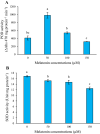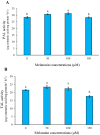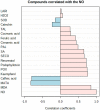Exogenous melatonin induces phenolic compounds production in Linum album cells by altering nitric oxide and salicylic acid
- PMID: 36914704
- PMCID: PMC10011386
- DOI: 10.1038/s41598-023-30954-9
Exogenous melatonin induces phenolic compounds production in Linum album cells by altering nitric oxide and salicylic acid
Abstract
Melatonin is a pleiotropic molecule that can influence various aspects of plant performance. Recent studies have exhibited that it mediates plant defensive responses, probably through managing redox homeostasis. We tried to track the regulatory effects of melatonin on the antioxidant machinery of Linum album cell culture. To this, different concentrations of melatonin were applied, and the oxidative status of cells was investigated by measuring the levels of oxidative molecules and antioxidant agents. The results showed that H2O2 content did not change at the low melatonin levels, while it increased at the high concentrations. It can be correlated with the low melatonin dosages capacity to remove excessive amounts of H2O2, while the high melatonin dosages exhibit toxicity effects. In contrast, the NO enhancement occurred at 50 μM melatonin, proposing its role in triggering melatonin-induced defensive responses. The MDA results stated that NO led to oxidative stress in melatonin-treated cells at 50 μM melatonin. Antioxidant enzyme POD was activated by melatonin treatment, while SOD enzyme behaved reversely which can explain the changes in the H2O2 level. In addition, the analysis of the phenolics profile showed that the contents of phenolic acids, flavonoids, and lignans enhanced following an increase in PAL enzyme activity. The increased level of phenolic hormone SA can indicate that melatonin affects the defensive responses in L. album cells through a SA-dependent pathway. In general, it seems that melatonin, by modulating NO and SA levels, can induce the activity of antioxidant enzymes and the production of phenolics, especially lignans, in L. album cells.
© 2023. The Author(s).
Conflict of interest statement
The authors declare no competing interests.
Figures







References
-
- Arnao MB, Hernández-Ruiz J. Is phytomelatonin a new plant hormone? J. Agron. 2020;10(1):95.
Publication types
MeSH terms
Substances
LinkOut - more resources
Full Text Sources

